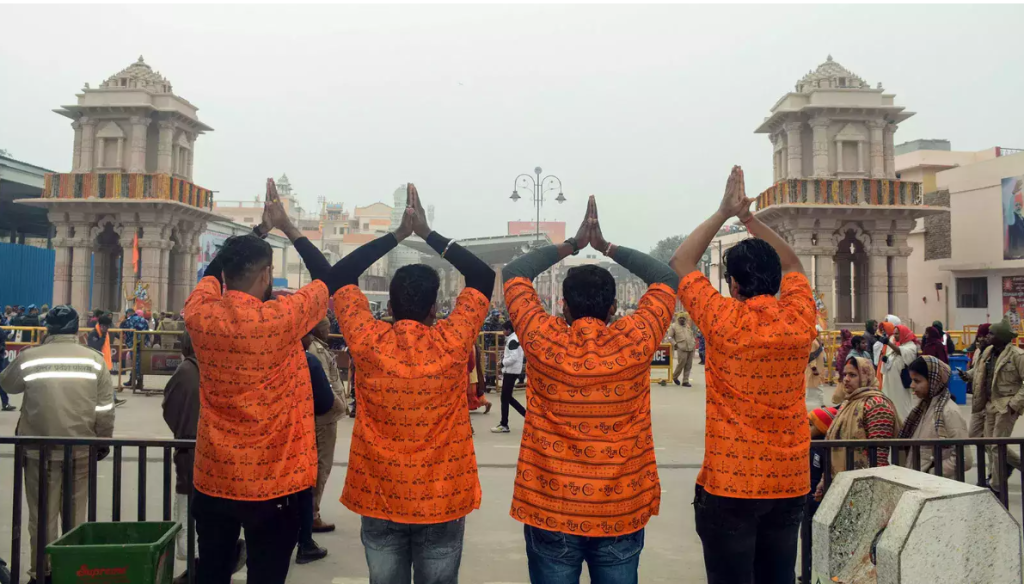For Hindus, a tirth sthal is about seeking and fulfilling a search for one’s own salvation
Prime Minister Narendra Modi succeeded in making the inauguration of the Ram temple at Ayodhya one of the most-watched events in the history of Indian television. Can he harness that religious fervour to convert Ayodhya from a town with a large temple into a tirth sthal (holy place of pilgrimage)? That will decide whether expectations of a fabulous tourism bonanza at Ayodhya will be fulfilled.
Yogi Adityanath seeks to create a new religious tourism triangle covering Ayodhya, Varanasi and Prayagraj (former Allahabad). He expects this to rival, hopefully surpass the traditional Delhi-Agra-Jaipur tourism triangle.
He has invested massively in infrastructure to facilitate this, including an airport at Ayodhya. Investment bank Jefferies thinks Ayodhya can be developed to attract five crore visitors per year. Developers have swooped in, bought land in the region and are reportedly asking for Rs 1.5 crore per plot. Will their gamble work?
Religious tourism in India is very big; almost two-thirds of all tourism. Vaishno Devi in Jammu gets far more visitors than the famed Kashmir Valley. The Taj Mahal may be India’s most famous tourist attraction, but official Uttar Pradesh data shows that Agra received less than a crore visitors in 2023 till September 30, against 2 crore in Ayodhya, 4.5 crore in Prayagraj (formerly Allahabad) and 8.4 crore in Varanasi. Religious tourism beats cultural tourism hands down.
The controversy over demolishing the Babri Masjid and building a Ram temple stirred up unprecedented interest, so footfalls in Ayodhya rose tenfold. But will this be a temporary phenomenon that peters out? Will Ayodhya become a new tirth sthal, or remain a town with a grand temple? Delhi’s Akshardham Temple attracts tourists galore, but does not make Delhi a tirth sthal.
For Hindus, a tirth sthal is not about visiting a temple, but about seeking and fulfilling a search for one’s own salvation. Nobody travels to Badrinath or Gangotri to see a temple: they go because the journey — which once took 40 days on foot but has been greatly shortened by bus — is a form of effort and sacrifice of time to gain spiritual bliss.
Tens of crores of Hindus visit the 12-year Kumbh Mela at Prayagraj, and most do not visit any temple there. They go for the joy of joining lakhs of fellow Hindus every morning in taking a dip at the holy junction of the Ganga and Jamuna.
Crores of Hindus every year visit Rishikesh, Haridwar, Varanasi and Prayagraj to bathe in the holy Ganga. They believe that Ganga water is pure, or amrit (nectar), even though it is terribly polluted. The ecstasy of the holy dip is anchored in faith, not mundane environmental realities.
The Sarayu River at Ayodhya is not sacred. It is as polluted as the Ganga but has no mythological claim to purity. Ayodhya has never been a place for Hindu pilgrimage even though the BJP has been claiming for years that the spot at which the Babri Masjid was destroyed — and where the new temple has been built — is the exact birthplace of Ram.
The four Shankaracharyas did not attend Modi’s inauguration of the Ram temple, and two were outspokenly critical. The Puri Shankaracharya declared, “The pilgrimages are now being turned into centres of tourism in the name of development, which means that tirth sthals are being turned into bhogsthals (restaurants). Perhaps this is what is being lapped up by the people also in the name of development. Politicians will interfere in religion in future and publicise themselves as yogis and dharmacharyas.”
This was strong language, but Shankaracharyas are not heads of religion. Hindus can, and did ignore them at the consecration. Regardless of objections of the Puri Shankaracharya, the BJP mixes religion and politics to the maximum possible extent.
The temple inauguration was proof that Modi mattered more to crores of Hindus than the Shankaracharyas. Modi called the event a second return of Ram, a divine moment, and asked Hindus to celebrate a second Diwali. They duly did so, bursting firecrackers, lighting diyas and distributing sweets as in the real Diwali.
So, will public fervour of the moment be sustained? The Ram temple by itself cannot become a tirth sthal: that is not how Hinduism functions. Going by historical precedent, converting Ayodhya into a tirth sthal cannot be done quickly, if at all.
This article was originally published by The Times of India on January 27, 2023.


